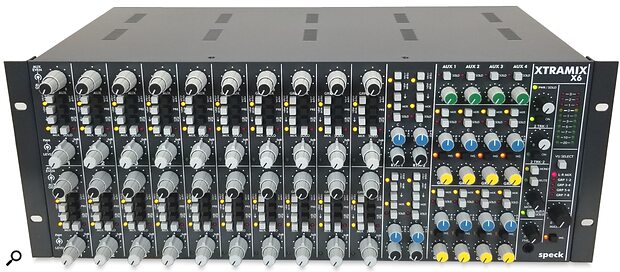The original Speck Xtramix rackmount mixer was released in 1992, at the height of the MIDI studio revolution, when ROMplers, rackmount samplers, digital effects units and traditional keyboards were all competing for mixer channels in the home studios of the day. Speck revised the original design a number of times, and indeed were still making Xtramixes right up until 2011, but by then our love affair with computers and soft synths had all but killed the market for high-channel-count, line-level rackmount mixers.
A decade later, and hardware synths are very much back in fashion. Many of the current generation of synths and desktop modules are also so affordable that even a modest setup can take up a dozen channels or more — leaving only the problem of how to hook them all up. The rackmount mixer would seem to be the ideal format for people who want to hear the live outputs from all of their synths without having to re-patch them, but so dry has been the market of late that, unlike large, second-hand fader consoles whose value has plummeted over the years, old rack units like the Mackie LM3204, Tascam MM-100 and Speck Xtramix have started to command premium prices.
Maybe Speck have been keeping an eye on eBay prices themselves, because they've just announced an Xtramix revival. The new Xtramix X6 crams no fewer than 20 input channels, four aux sends, four stereo aux returns, eight groups, a pair of two-track inputs, two monitor outputs plus a main stereo mix bus into a 4U rack. For a true sense of how many JV-1080s and Alesis MIDIverbs it'll handle, a look at the back panel (see below) is instructive. There you'll find no fewer than 130(!) balanced jack sockets, among them direct outputs for each stereo channel, and balanced insert sends/returns for all the groups plus the main mix.
 Xtramix 6 rear panel boasts no fewer than 130 balanced jack sockets!
Xtramix 6 rear panel boasts no fewer than 130 balanced jack sockets!
With so much connectivity and so many routing options, the front panel is necessarily a bit of a squeeze, but Speck have managed to fit all the important stuff in, mostly thanks to their judicious use of dual-concentric pots (slender fingers are recommended).
Full technical specifications are yet to be published, but if they're anything like those of previous generation Xtramixes, then they'll likely be very good indeed. Their website states: "The X6 has high headroom that will handle balanced signals up to +28dBu."
Check out the link below for more details.

